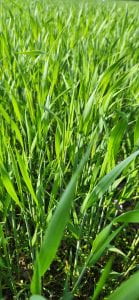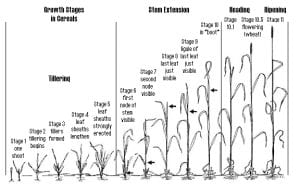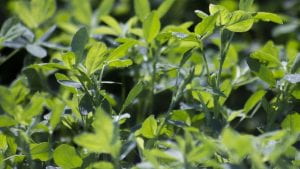This is the team’s second week of monitoring heights for first cutting quality in 2023. The full report for our six-county region (Broome, Cayuga, Chemung, Cortland, Tioga, Tompkins Counties) can be found in the following link: Alfalfa Height Reporting Sheet 5.9.23.
This week’s updates:
A word of caution to start out our report this week. Most of our numbers suggest that the time is now to start harvest of all grass fields for peak NDF quality. As PRO-DAIRY’s Joe Lawrence shares:
No doubt some grasses are going to be ready early this year with the weather we have had. As you look at grass harvest just a reminder that occasionally we run into a scenario where the grass head is still below the cutter bar of the mower (~4”) which leads to some untimely heading shortly after 1st cutting and reduced grass performance for second cutting. Below is an example based on a field Mike Hunter visited a few years ago in the North Country. Grass heading after 1st cut
On our travels, it’s been amazing to see how last week’s sogginess has been replaced by a vibrant growing crop and fields have started to even out. Yesterday there were plenty of corn planters moving across fields. Intention should be taken to harvest hay when it’s ready for peak quality, and be willing to park the planter for a few days to get the hay crop in. A drive to check out field progression in the next few days may help you figure out field order to harvest in and which fields should potentially be set aside for higher NDF heifer feed.
Broome: This week’s heights averaged 17.5″, only a 2″ gain over last week’s heights. As grass harvest should start when nearby alfalfa fields are 15″, now is the time to harvest all grass fields. Our report indicates that a 50/50 mix harvest may be ready within the week.
Cayuga: This week’s average height was 16.2″, almost a 4.5″ gain over last week. Grass harvest should be started here, with a 50/50 mixed harvest to start in the next week as well.
Chemung: Huge height gain in Chemung county this past week, almost gaining 7″ in height, with our average in fields measured coming in at 18.3″. Grass harvest should be underway, and 50/50 mixes soon to follow.
Cortland: Again, our lowest height average this week coming in at 13.3″, a gain of 3″ over last week. In this county, like Tioga, elevation plays a huge role and fields in the valleys may be further ahead of hill ground. A drive to see where fields are progressing will be important to capture peak grass quality, if that’s the goal.
Tioga: A close second, coming in at 17.6″ average height, Tioga county fields gained almost 5″ in height over last week. Hay crop, again while elevation dependent like Cortland, may be much different on hill ground than in the valleys.
Tompkins: Fields were seen being harvested in Tompkins County yesterday. Average height this week came in at 16.8″, with a gain of almost 4″ over last week.
A word on Cover Crop Harvest
Cover crop fields we visited this spring varied from vibrant green and lush, to yellow and struggling. Many of those washed-out yellow fields benefited from additional N application and have taken off after receiving some heat and sunlight. With temperatures rising to near 80 degrees this week, many fields are primed to mature rapidly. 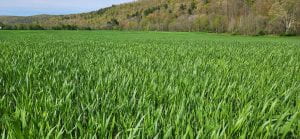
Some fields I checked yesterday were in Stage 7-8 of Feeke’s scale. We want to harvest cover crop at flag leaf for peak quality, and with some heat, many fields will be there soon. Waiting to boot stage will add tonnage, but will also increase NDF of the forage. Knowing what the plan is for this feed will help you determine at which stage you should harvest. As always, make sure to pack this harvested feed well in the bunk, especially if it’s harvested at a more mature stage.
A Reminder on our Methods
For prediction of NDF content, the height of alfalfa as an indicator is as follows:
- 100% grass stands – cut when nearby alfalfa is 14 inches tall (achieves 50% NDF)
- 50/50 grass/alfalfa stands – cut when nearby alfalfa is 22 inches tall (achieves 44% NDF)
- 100% alfalfa stands – cut when alfalfa is 28 inches tall (achieve 40% NDF)
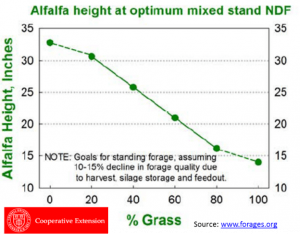
Predicted days to cut are based on daily NDF increases for grasses of 1.0% point, 50/50 mixed alfalfa/grass stands of 0.8% points, and alfalfa of 0.5% points and are adjusted for the coming week’s weather. Typically NDF increases about 0.8 to 1.2 per day for grasses, with cooler weather being the lower end of the range and warmer weather being the higher end. For alfalfa, NDF increases about 0.4 to 0.7 per day, also dependent upon warm/cool weather.
Next Report
Look for our next report of monitoring heights to come out on Wednesday, May 17th. In the meanwhile, if you can’t get out to check your fields, call one of us on the team. We’ll be glad to help out.

